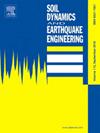Wave propagation characteristics and parameter sensitivity analysis of Longmaxi shale in deep oil and gas reservoirs under multiple dissipation mechanisms
IF 4.2
2区 工程技术
Q1 ENGINEERING, GEOLOGICAL
引用次数: 0
Abstract
Longmaxi Formation shale is widely distributed and resource rich, making it one of the key target formations for shale gas exploration and development in China. This shale is typically characterized by low porosity and low permeability, representing a typical dense unconventional oil and gas reservoir. In practical oil and gas exploration, fluctuation response signals are extensively used for reservoir parameter identification and structural analysis. The traditional Biot model provides a preliminary description of wave propagation behavior in porous media from the perspective of energy conservation; however, it often underestimates energy dissipation and wave attenuation, which limits its accuracy when applied to complex shale reservoir conditions. To establish a propagation model that accurately captures the wave dissipation mechanisms in deep shale reservoirs, a frequency-dependent dynamic tortuosity analysis method based on energy conservation and mass invariance is proposed, taking into account the effects of irregularities in mineral particles and pore channels on tortuosity in actual reservoir shales. Additionally, time-varying correlated nonlinear viscoelastic constitutive relations are introduced to characterize the mechanical behavior of the solid skeleton, enabling the construction of wave field equations applicable to fluid–pore media systems under different frequency conditions. On this basis, the Biot model is improved by refining the mechanisms of frictional dissipation, internal dissipation, and relaxation dissipation in the wave field equations, resulting in the development of a wave propagation model—the WMDM model (Wave propagation model under Multiple Dissipation Mechanisms), which is suitable for a multiband frequency range. Comparative analysis of the numerical calculations and wave velocity test results of the Longmaxi shale model reveals that the WMDM model significantly improves the prediction accuracy of the shale wave velocity dispersion and attenuation characteristics in the low-frequency range and clearly reveals three distinct dispersion zones and attenuation peaks across the full frequency band. Through sensitivity parameter analysis, it is revealed that liquid saturation, fluid type, and porosity influence the wave propagation process by modulating the effective density, modulus, and coupling relationship between fluid flow and the solid matrix. Moreover, a hybrid SSA-GA inversion method that combines the sparrow search algorithm (SSA) and genetic algorithm (GA) is proposed to address the challenge that the model's viscoelastic parameters are difficult to measure directly. A comparison of the inversion results obtained by different algorithms demonstrates that the hybrid algorithm outperforms traditional methods in terms of global search capability, inversion accuracy, and computational efficiency and successfully captures the frequency-dependent behavior of the actual wave velocity.
多重耗散机制下龙马溪页岩深层油气波传播特征及参数敏感性分析
龙马溪组页岩分布广泛,资源丰富,是中国页岩气勘探开发的重点目标层之一。该页岩具有典型的低孔低渗特征,是典型的致密非常规油气藏。在实际油气勘探中,波动响应信号被广泛用于储层参数识别和构造分析。传统的Biot模型从能量守恒的角度对波在多孔介质中的传播行为进行了初步描述;然而,它往往低估了能量耗散和波衰减,这限制了其在复杂页岩储层条件下的准确性。为了建立准确捕捉深层页岩储层波耗散机制的传播模型,考虑实际储层页岩中矿物颗粒和孔隙通道的不规则性对弯曲度的影响,提出了一种基于能量守恒和质量不变性的频率相关动态弯曲度分析方法。此外,引入时变相关非线性粘弹性本构关系来表征实体骨架的力学行为,从而建立适用于不同频率条件下的流孔介质系统的波场方程。在此基础上,通过细化波场方程中的摩擦耗散、内耗散和松弛耗散机制,对Biot模型进行了改进,形成了适用于多频段频率范围的波传播模型——WMDM模型(wave propagation model under Multiple耗散机制)。通过对龙马溪页岩模型数值计算与波速测试结果的对比分析表明,WMDM模型显著提高了页岩低频波速频散与衰减特征的预测精度,清晰地揭示了全频段3个明显的频散带和衰减峰。通过灵敏度参数分析,揭示了流体饱和度、流体类型和孔隙度通过调节有效密度、模量以及流体与固体基质之间的耦合关系来影响波的传播过程。此外,针对模型粘弹性参数难以直接测量的问题,提出了一种结合麻雀搜索算法(SSA)和遗传算法(GA)的SSA-GA混合反演方法。不同算法反演结果的对比表明,混合算法在全局搜索能力、反演精度和计算效率方面优于传统方法,并成功捕获了实际波速的频率依赖行为。
本文章由计算机程序翻译,如有差异,请以英文原文为准。
求助全文
约1分钟内获得全文
求助全文
来源期刊

Soil Dynamics and Earthquake Engineering
工程技术-地球科学综合
CiteScore
7.50
自引率
15.00%
发文量
446
审稿时长
8 months
期刊介绍:
The journal aims to encourage and enhance the role of mechanics and other disciplines as they relate to earthquake engineering by providing opportunities for the publication of the work of applied mathematicians, engineers and other applied scientists involved in solving problems closely related to the field of earthquake engineering and geotechnical earthquake engineering.
Emphasis is placed on new concepts and techniques, but case histories will also be published if they enhance the presentation and understanding of new technical concepts.
 求助内容:
求助内容: 应助结果提醒方式:
应助结果提醒方式:


